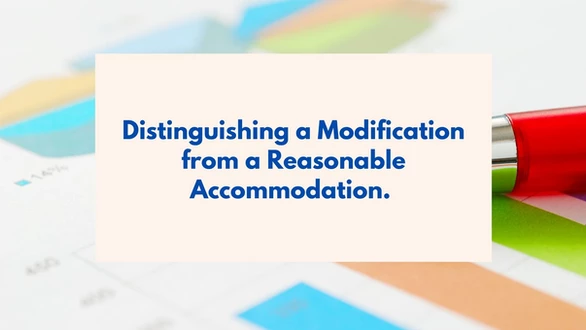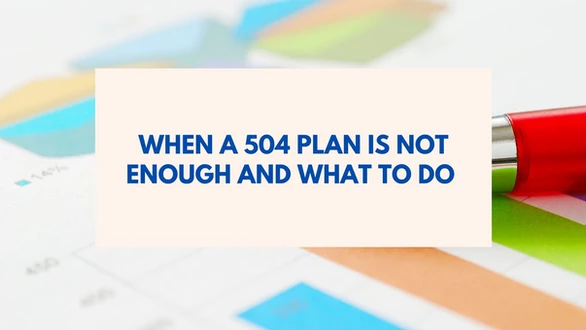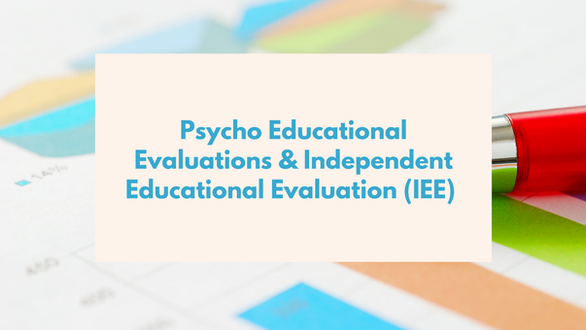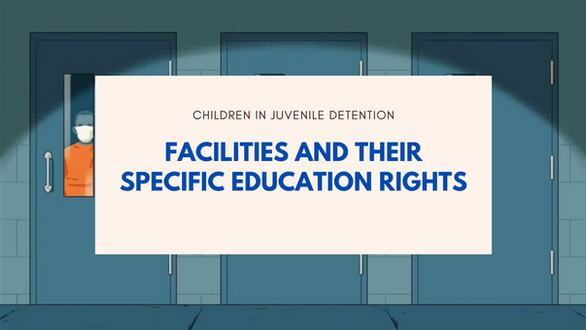INTRODUCTION
Some students with special needs have emotional, communication and social issues in addition to their difficulties with learning. When these students fail to understand, they become frustrated, or feel threatened in some way; their first response may be to lash out at the person closest to them. In the school setting, this is usually the teacher or paraprofessional. If they have an IEP or a 504 plan, what happens if they break a school rule? Can they be disciplined? And if so, how?
IDEA was amended to better ensure that children with disabilities whose behavior blocks learning have those behaviors addressed within their IEP. Although this was expected practice prior to IDEA ’97, it was seldom implemented; children with such needs were underserved and punished and too frequently dropped out of school. The amendments also balance intervention with safety, allowing school staff to remove children from their school for possession of a weapon or drugs (including drug sale or use). One remedy allowed by the IDEA ’97 is placement in a 45-day alternative placement. Other options can be tried, including parent-supported change in placement and IEP. More complex is the removal by hearing examiner of a child when there is a preponderance of evidence that maintaining the child in the present placement is substantially likely to result in injury to the child or to others.
This article is designed to provide a set of practical concepts to improve the chances that positive behaviors will increase and negative behaviors will decrease among children with disabilities who warrant special education and related services under IDEA. It also examines the protections for students with IEPs and 504 plans who make Violent threats at School as well as engage in other negetive behavior.
School Discipline Code and the rights of students/parents
School systems have the legal responsibility to maintain safe, violence-free schools. Part of that responsibility includes the establishment of a code of conduct containing specific consequences for violations of the code. All students, including students with IEPs and 504 plans, must follow school rules.
The code might include rules like no obscene language, no disrupting classes and no smoking. It may have a dress code, academic rules and attendance requirements. The code should also spell out the consequences for breaking rules.
When it comes to school discipline, all students have some basic rights:
- Students (and their parents) have the right to know beforehand what the rules are.
- If a school accuses a student of breaking a rule, the student has a right to challenge the accusation and prove her innocence. This may happen informally at a meeting with the principal, or more formally at a superintendent’s hearing.
- A school can’t have rules that violate a child’s constitutional rights. For instance, a school can’t discriminate against a child due to race or religion.
- or religion.
Discipline Protections for Kids With IEPs and 504 Plans
In addition to the basic rights all students have with school discipline, the Individuals with Disabilities Education Act (IDEA) provides special protections to students with IEPs. These same rights apply to kids with 504 plans.
If your child doesn’t have an IEP or a 504 plan, IDEA protections may still apply if:
- You’ve requested an evaluation of your child from the school.
- The school’s administration had a reason to know your child has a disability.
The school discipline rules in IDEA are very complicated. So if your child is facing school discipline, it can help to get the advice of a special education advocate or attorney.
The rules are easier to understand when you consider the purpose of IDEA: to provide the educational services kids with disabilities need to learn. So protections apply in two broad situations:
- When there’s a change in placement that prevents a child from receiving services—for example, being removed from school.
- When a child’s misbehavior is caused by her disability. In this case there would be a process called “manifestation determination.”
Change in Placement
When a child is removed from school as part of discipline, he’s unable to receive the services in his IEP or 504 plan. So after a certain amount of time, IDEA requires those services to be provided wherever the child is. This is sometimes known as the “10 Day Rule.”
If a child is removed for 10 school days or less, he’s treated just like other students. For example, if a child is sent home for seven days because of fighting, typical school policies for suspended students apply.
Some states require schools to provide home instruction for kids who are suspended. That includes IEP and 504 plan services. But other states don’t. If your child is removed from school, you can call an IEP meeting to discuss concerns you may have about services.
Once a child reaches more than a total of 10 school days of removal, it’s considered a “change in placement” under IDEA. (It doesn’t have to be 10 days in a row—just 10 total days.)
When there’s a “change in placement,” IDEA provides increased protections:
- The school must immediately notify you in writing of the change and inform you about your legal rights and protections (called procedural safeguards).
- If it’s not doing so already, the school must provide the educational services in your child’s IEP or 504 plan. For example, if a child is moved to a special detention center, starting on the 11th day, IDEA says he must receive her educational services in this new “placement.”
- The school must conduct a special review called a “manifestation determination.”
Manifestation Review
When the IEP has already addressed problem behavior, the team has valuable information about the relationship between the child’s disability, the behavioral concerns, the components of the IEP and classroom, including the services provided, the IEP team, assisted by qualified professionals, should determine if the student’s behavior (misconduct as defined) is related to the disability and whether the current placement is appropriate by evaluating all factors related to the students’ behavior and IEP. This should include review of the interventions tried and services provided to prevent the presenting problem. Such a review should be comprehensive and focus on multiple factors, not merely the behavioral goals of the child’s IEP.
The determination that a behavior is a manifestation of the child’s disability can be a complex process. It must be determined by qualified professionals, on an individual, case-by-case basis. It cannot be determined by the child’s label or category.
1.) There are three possible results of a manifestation determination:
When the dangerous behavior is the result of the disability, expulsion is an inappropriate action. The child cannot be expelled for that behavior. However, this does not mean that the child must remain in the present placement. When it is determined that the placement or the IEP is not meeting the child’s behavioral needs, modifications should be made to IEP and, if necessary, to the placement and needed services, to assure that the behavior will be addressed and to prevent its reoccurrence. When dangerous behavior such as weapons violations continue, a controlled, secure placement may be necessary. Any placement should continue FAPE as well as addressing the behaviors of concern. When parents have been involved in the development of the IEP, including the behavioral goals and services, agreement is more likely to occur between school and family regarding modifications in the program and changes in placement.
2.) When the misbehavior happened because some aspect of the IEP wasn’t followed
In this case, the school must immediately fix the situation and implement the IEP (or 504 plan) properly. The student can return to school. Again, there’s an exception if she was removed because of a weapon or illegal drugs, or for having caused serious bodily injury to someone. If these apply, she can be kept out of school for 45 school days.
3.) When Behavior is Not a Manifestation of the Child’s Disability
A child with a disability, whose dangerous misconduct is found to be unrelated to his/her disability and whose IEP, program and services are appropriate to address the child’s needs, may be subject to the regular discipline code of consequences, provided that the child continues to receive FAPE. The parent continues to have the right to appeal this decision and any decision regarding placement. Even when the behavior remains a perceived threat or danger to the child and/or others, FAPE should continue but may need to be provided within a more restrictive alternative center where control reduces danger. Restrictive alternatives may include, for example, a juvenile detention center, residential treatment center or other secure facility. It is not in the child’s, the school’s, community’s or family’s interest to maintain a child using an existing IEP and placement when the weapons or dangerous behavior cannot be effectively addressed within that placement. It is in no one’s interest to terminate FAPE to a child with a disability who is in need of special education and related services.
Restraint and Seclusion
Students with disabilities are more likely to be restrained and secluded at school. These discipline practices, like holding kids down or putting them in locked rooms, are very controversial.
Most states don’t have laws banning restraint and seclusion. That means public schools are often free to decide when and how to use these practices. However, for kids with IEPs and 504 plans, there are limits.
- Schools can’t restrain or seclude a child with an IEP or a 504 plan if they wouldn’t do the same to other kids. For example, if two kids misbehave in the same way, the school can’t restrain one child just because she has ADHD.
- Schools also can’t have a policy on restraint or seclusion that has a bigger, more negative impact on kids with IEPs and 504 plans than it has on other kids.
- Schools can’t restrain or seclude a child in a way that would deny her a free and appropriate public education (FAPE). Repeatedly placing a child in a room alone, for instance, may limit her learning.
It’s important to review your child’s IEP or 504 plan to make sure there’s nothing in it that permits restraint or seclusion. If these methods are used with your child, you can call an IEP meeting to raise your concerns. You can also file a complaint with state or federal officials. And if you ever see any evidence of child abuse, you have the right to call the police.
CONCLUSION
Children who have disabilities that prevent them from understanding or responding appropriately to components of a discipline code or school rule should have those exceptions incorporated and addressed in their IEP. IEPs are designed to address both traditional academic needs and to meet “each of the child’s other educational needs that result from the child’s disability.” The law also says that schools shall consider, when needed, “strategies, including positive behavioral interventions, strategies and supports to address that behavior” that impedes learning.











